1) The following diagram represents the structure of a non-essential vitamin
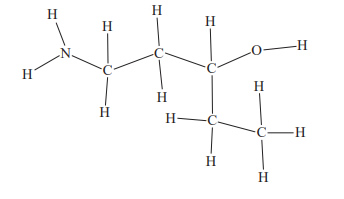
1) What is the IUPAC name of the molecule shown above?
A. 3-hydroxy-3-ethyl-propan-1-amine
B. 3-amino-1-methylpropan-1-ol
C. 3-hydroxypentan-1-amine
D. 1-aminopentan-3-ol
Solution

2)The metabolic process that produces water is:
A. the digestion of fats.
B. cellular respiration.
C. the hydrolysis of starch.
D. the breakdown of protein into amino acids.
Solution

3) How many structural isomers have the molecular formula C3H6BrCl?
A. 4
B. 5
C. 6
D. 7
Solution

The diagram below represents a section of an enzyme.
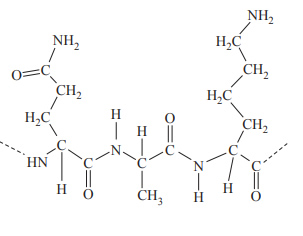
4) The diagram can be described as a
A. secondary structure consisting of glutamine, glycine and lysine.
B. primary structure consisting of asparagine, glycine and lysine.
C. secondary structure consisting of asparagine, alanine and lysine.
D. primary structure consisting of glutamine, alanine and lysine.
Solution

5) The following table provides information about three organic compounds, X, Y and Z
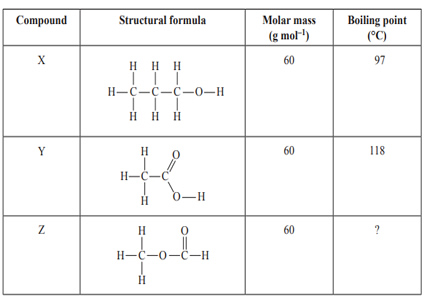
Which one of the following is the best estimate for the boiling point of Compound Z?
A. 31 °C
B. 101 °C
C. 114 °C
D. 156 °C
Solution

6) The heat of combustion of ethanoic acid, C2H4O2, is −876 kJ mol-1 and the heat of combustion of methyl methanoate, C2H4O2,
is −973 kJ mol-1 .
The auto-ignition temperature (the temperature at which a substance will combust in air without a source of ignition) of ethanoic acid is
485 °C and the auto-ignition temperature of methyl methanoate is
449 °C.
Which one of the following pairs is correct?
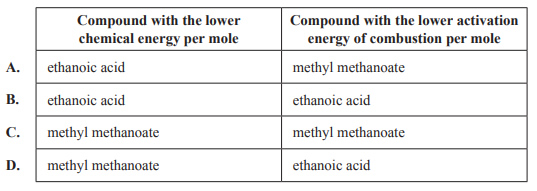
Solution
7) Which of the following combinations of bonds can be broken during the breakdown of a protein that a person has eaten?
A. covalent bonds in the secondary structure and hydrogen bonds in the primary structure
B. covalent bonds in the tertiary structure and hydrogen bonds in the secondary structure
C. covalent bonds in the secondary structure and hydrogen bonds in the tertiary structure
D. covalent bonds in the quaternary structure and hydrogen bonds in the primary structure
Solution

8) The following diagram represents a reaction pathway starting with
hex-3-ene
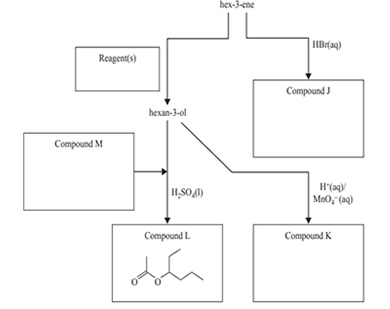
a. Write the IUPAC name of Compound J in the box provided.
b. State the reagent(s) required to convert hex-3-ene to hexan-3-ol in the box provided.
c. Draw the structural formula for a tertiary alcohol that is an isomer of hexan-3-ol.
d. Hexan-3-ol is reacted with Compound M under acidic conditions to produce Compound L. Draw the semi-structural formula for Compound M in the box provided.
e. i. Draw the semi-structural formula for Compound K in the box provided
ii. Name the class of organic compound (homologous series) to which Compound K belongs.
f. What type of reaction produces Compound K from hexan-3-ol?
Solution
